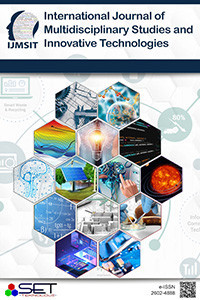Hava Lidar ve fotoğraflardan kentsel alanların digital ikizinin oluşturulması ve karşılaştırılması
Lidar, photogrametry, point cloud, jeodetic koordinate, urban area modelling
Digital twin generation and comparison from aerial Lidar and images in urban area
Lidar, photogrametry, point cloud, jeodetic koordinate, urban area modelling,
___
- [1] N. Haala, M. Kölle, M. Cramer, D. Laupheimer and F. Zimmermann, "Hybrid georeferencing of images and LiDAR data for UAV-based point cloud collection at millimetre accuracy," ISPRS Open Journal of Photogrammetry and Remote Sensing, vol. 4, 100014, 2022.
- [2] Y. Zhang and X. Shen, "Direct georeferencing of airborne LiDAR data in national coordinates," ISPRS Journal of Photogrammetry and Remote Sensing, vol. 84, pp. 43-51, 2013.
- [3] A. Fekete and M. Cserep, "Tree segmentation and change detection of large urban areas based on airborne LiDAR," Computers & Geosciences, vol. 156, 104900, 2021.
- [4] K.Z. Kulawik, K. Skoczylas, P. Wężyk, J. Teller, A. Mustafa and H. Omrani, "Monitoring of urban forests using 3D spatial indices based on LiDAR point clouds and voxel approach," Urban Forestry & Urban Greening, vol. 65, 127324, 2021.
- [5] K.Z. Kulawik, P. Hawrylo, P. Wezyk, P. Matczak, P. Przewozna, A. Inglot and K. Maczka, "Improving methods to calculate the loss of ecosystem services provided by urban trees using LiDAR and aerial orthophotos," Urban Forestry & Urban Greening, vol. 63, 127195, 2021.
- [6] J.F.F. Alvarado and S.F. Rodriquez, "3D environmental urban BIM using LiDAR data for visualisation on Google Earth," Automation in Construction, vol. 138, 104251, 2022.
- [7] J. Jin, J. Verbeurgt, L.D. Sloover, C. Stal, G. Deruyter, A.L. Montreuil, S. Vos, P.D. Maeyer and A.D. Wulf, "Support vector regression for high-resolution beach surface moisture estimation from terrestrial LiDAR intensity data," International Journal of Applied Earth Observation and Geoinformation, vol. 102, 102458, 2021.
- [8] S.I. Granshaw, "Structure from motion: Origins and Originality," The Photogrammetric Record, vol. 33, no. 161, pp. 6-10, 2018.
- ISSN: 2602-4888
- Yayın Aralığı: Yılda 2 Sayı
- Başlangıç: 2017
- Yayıncı: SET Teknoloji
Modeling Naval Mine Warfare with Machine Learning Algorithms
Hakan AKYOL, Ragıp ZİLCİ, Caner TABAN
Hava Lidar ve fotoğraflardan kentsel alanların digital ikizinin oluşturulması ve karşılaştırılması
Melisa GÖZET, Ulaş FİLİZ, Asım Egemen YILMAZ
Gürgen Ağacı Talaşı Dolgulu Epoksi Matrisli Kompozit Yapıların Mekanik Özelliklerinin İncelenmesi
Generating Personalized Abstract Art Paintings by using People's Life Energy Distribution
